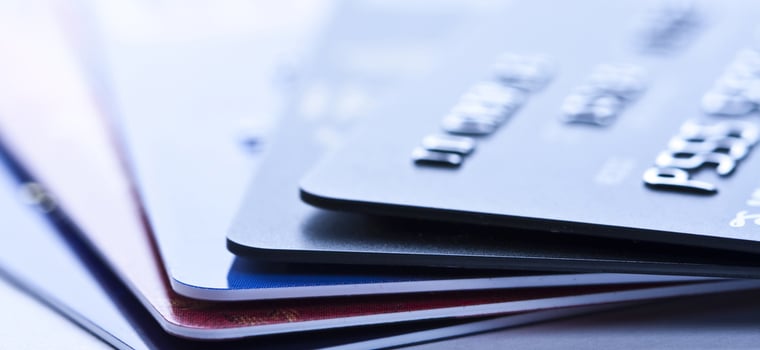According to modern statistics, 72% of Americans carry a credit card and owe an average debt of $8,512. We use credit cards so routinely that the total revolving consumer credit debt in the United States is now $1.086 trillion. It’s no wonder, then, that almost everyone knows what a credit card is and most likely has some experience using one.
While credit card use is commonplace today, it wasn’t always this way. Early forms of credit date back for thousands of years. Additionally, it wasn’t until 1950 that the Diners Club card set the stage for the current credit card era.
The Diners Club card was the first to give consumers the ability to make purchases at numerous businesses. But unlike most credit cards today, you had to pay the entire balance each month. The card was an innovative step forward on a centuries-old practice.
Credit cards have come a long way from the Diners Club. Let’s take a look at the history of credit cards, how they’ve evolved and what’s next.
Early Forms of Credit
The earliest recorded example of credit traces back to the Code of Hammurabi thousands of years ago. However, modern credit as we know it began around 1885 when hotels and department stores started allowing loyal customers to use paper store credit cards. These cards could only be used at one location, although competing merchants often accepted cards from competitors to drive business.
This form of specialized credit continued for a while, but it wasn’t until 1946 when John Biggins, a banker from Brooklyn, debuted the first bank card system. This system, known as “Charg-It” cards, worked similarly to the credit cards of today. That is, the customer paid the retailer with a credit card, the card issuer then reimbursed the retailer and sought payment from the customer.
The Charg-It card system worked primarily in New York, but this localized system quickly became a blueprint for larger credit networks, thus setting the stage for modern credit cards.
Diners Club and the Modern Credit Card
In 1950, Diners Club issued their first cards, and the modern era credit-card payment system was born. Unlike today’s cards, this charge card required a complete payoff of the entire balance each month rather than defining smaller minimum payments. However, the primary mechanism of offering easy-to-use credit caught on quickly and became a staple of higher-income purchasers.
1958 saw two competitors jump into the payment card scene: American Express Company and Bank of America. Both rolled out their first charge cards in 1958 to capitalize on the credit card market. The latter’s card, called BankAmericard was the first to offer revolving credit. This meant you could carry a balance, up to a credit limit of $300.
Following these two pioneers, Mastercard launched their own products in 1979. Previously, the company was called The Interbank Card Association. before being rebranded as Master Charge in 1968 to reflect their new products.
Discover Card burst onto the scene in 1986. The card was launched by Dean Witter Financial Services Group, Inc., a subsidiary of Sears.
Along the way, the technology of credit cards evolved as well. Up until 1969, credit cards didn’t have magnetic strips. Instead, retailers would use machines to capture imprints of credit cards with the information needed to process transactions. A copy was then sent to a processing center where a clerk would enter the credit card information into a computer system.
1969, IBM developed the standard for magnetic strips, making it possible for people to use credit cards to transmit card information around the globe. Mag stripes have now been in use for over 50 years.
The magnetic stripe system remains in use today, but it is undergoing a shift to EMV chip technology. EMV chips are designed to make credit card transactions more secure by generating unique and temporary codes to approve transactions.
The transactions are encrypted, making it far more difficult for hackers to penetrate. The computer chips also make it more difficult to counterfeit than magnetic stripes.
Legislation Steps In
The credit card industry has grown from thousands of card users to millions but information about fundamental credit rules hasn’t always been clear.
In the past, information about credit card interest rates and how they were calculated was not transparent. Lenders often disguised excessively high rates by using several different methods of calculating interest. Some lenders even used monthly interest rates while others used annual rates.
Other problems surfaced as well, such as cardholders receiving fraudulent charges on their accounts. Information from credit card issuers was often murky and very few disclosures could be found.
What’s more, women typically could not qualify for a credit card without a male co-signer.
After an eight-year study, Congress eventually stepped in and introduced the Truth in Lending Act in 1968. This legislation became a part of the Consumer Credit Protection Act (CCPA). This act introduced a standardized method of calculating annual percentage rates (APRs).
More protections were added to the CCPA throughout the 1970s. Ultimately, it became illegal to discriminate against credit card applicants based on sex, race, marital status and other reasons. The act also limited a cardholder’s liability for fraudulent charges while requiring more transparent disclosures.
In 2009, President Barack Obama signed the Credit Card Accountability Responsibility and Disclosure Act, known as the CARD Act. This legislation was a large scale attempt to get tough on bad card issuer practices.
CARD Act laws, which are enforced by the Consumer Financial Protection Agency (CFPB), have reduced credit card costs by consumers by more than $100 billion over the past decade.
The Bottom Line
We’ve come a long way since the Diners Club Card and more changes are coming.
Mobile payments, for instance, are rising in popularity as a way to use your credit card. Consumers are using smartphones and devices to make payments. We’re also using credit cards online, without swiping or inserting cards into payment processing units.
Perhaps people will not use physical credit cards in the future, choosing instead to use a card payment app embedded in their smartphones.




